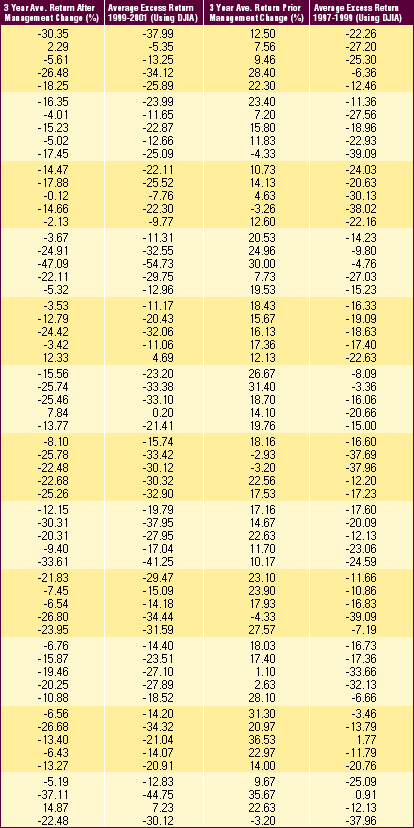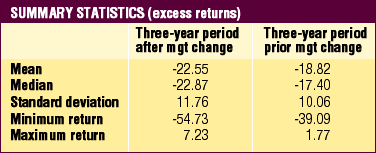
HOT TOPICS LIST
- Strategies
- Stocks
- Buy
- Investing
- Brokers
- Psychology
- Interviews
- Accumulate
- Sell
- Hold
- Spotlight
- Websites
- Candlestick Corner
- Gold & Metals
- Options Trading
LIST OF TOPICS
INVESTING
When Mutual Fund Managers Move On
09/10/03 09:40:51 AM PSTby Todd Marshall and J. Tim Query, Ph.D.
Does changing mutual fund management improve performance?
| With over $2.8 trillion currently under management by the mutual fund industry in the US today, mutual funds have become the tool of choice for many investors seeking balance between diversification and strong returns. While the pace at which capital is being allocated into funds has slowed due to recent diminishing returns, the appeal of mutual fund investing cannot be denied: The mutual fund truly came of age during the bullish market of the 1990s. During the 1990s, an exploding market saw new funds introduced daily by asset management firms, large and small. Returns of 20%, 30%, or even 50% were not uncommon, especially in the ultra-hot growth, technological, and telecommunications sectors. For example, Fidelity Select Electronics Fund was up 177.5% for the one-year period ended March 31, 2000. It had a five-year annualized return of 59.2%. INVESCO Technology Fund had a 170.3% return for the same one-year period. PBHG New Opportunities surged 164.8% in the final quarter of 1999, while PBHG Select Equity was up 130.6%. PBHG's Technology & Communications fund finished 1999 with a 243.9% gain. Technology sector funds were up an average of 63.82% in the fourth quarter of 1999, and had an average gain of 134.77% for the year. Market performance was so exceptional that more than $1.4 trillion found its way into the skillful hands of mutual fund managers in the US equity markets. The days of such remarkable returns are over. Investors, disappointed by reduced returns and volatile markets, have pulled their money out of mutual funds and opted for more conservative investment strategies such as bond funds, Treasury bills, gold futures, and the ever-popular investment approach of placing cash under the mattress. As fund companies witnessed the redemption of shares increase, many firms fired portfolio managers and brought in new ones to signal a turnaround in fund performance. Yet what has been the effect of such management change in the mutual fund industry? The adage about a rising tide floating all ships seems to have been reinforced during bull markets of the 1990s, but what happens now as the portfolio managers of that era are being replaced? Does a change in fund management precipitate better performance? We decided to analyze the performance of more than 50 mutual funds, before and after such a change, to determine the effect of such a strategy.
LITERATURE REVIEWSeveral studies have examined the consequences of a change in mutual fund management. BusinessWeek's Mara Der Hovanesian revealed that a shuffle in fund management did not have a strong effect, noting the extensive network of analysts working below the lead manager. However, Ajay Khorana, assistant professor of finance at the Georgia Institute of Technology, found that the replacement of overperforming managers led to reduced performance. Conversely, the replacement of a poorly performing manager was met with improved performance; the manager change was usually brought about by significant reduction in capital inflows. In an analysis of performance, risk, and investment style after a change in management, John G. Gallo and Larry J. Lockwood (University of Nevada associate professor of finance and Texas Christian University professor of financial services, respectively) noted that both performance and systematic risk increased after the change, coupled with a change in investment style. Fortune contributor William Sheeline addressed the tendency of fund companies to downplay the departure of a star manager, noting that most, but not all, star managers fade away once replaced. In this article, we extend the existing research in several ways. For one, previous research has included funds that undergo a change in investment style as well as alterations in risk tolerance within the portfolio. We also focus on funds that maintain the same investment style and category. Some previous research has also included bond funds in their study. The sample included here focuses on equity-based portfolios. Finally, research in this field has often focused on performance of large funds once star managers, such as famed portfolio manager Peter Lynch, have left the helm. In this study, however, we have chosen to encompass funds both small and large. This is a more recent study that focuses on performance during the raging bull market.
DATA AND METHODOLOGY
Compiled from a database listed by investor watchdog group fundalarm.com, a preliminary search of mutual funds undergoing a change in portfolio management during 1996-99 yielded an initial sample of 242 mutual funds. The rationale behind the release of some of the managers was somewhat ambiguous. Some were relieved for nonperformance reasons such as retirement, health, and family concerns as well as opportunities to head other funds at different firms and did not represent a true firing. Moreover, reasons behind management changes at a number of firms were not available. After controlling for reasons behind the change in personnel, the sample size was trimmed to just over 200 funds. The lack of historical data regarding the performance of various funds further reduced the usable sample size to 59 funds. From this new, smaller group, three-year average returns were calculated from data available at Morningstar and finance.yahoo.com. The year 1999 was used as the base year, representing the twilight of the market boom of the 1990s. Three-year average returns were calculated for both before and after a change in management. For example, if a management change occurred in 1999, the 1997-99 period was used as the three-year period prior to the change in management, and the years 1999-2001 were used as the three-year period benchmark after the change in management occurred. These three-year average returns were then compared to the performance of the Dow Jones Industrial Average (DJIA) to calculate excess returns. Negative values thus illustrate instances in which a given fund's three-year average performance was below that of the DJIA's three-year average performance. Positive values signify performance of a fund above that of the DJIA's three-year average.
RESULTSA significant decrease (smaller negative values or larger positive values) in average excess return after the management change occurred, compared to the average excess return prior to the management change, signaled an improvement in fund performance relative to the performance of the DJIA. Simply put, a reduction in average excess return would symbolize that the new manager improved performance via improved security selection. Conversely, a continued increase (larger negative values or smaller positive values) in average excess return after the management change occurred, compared to the average excess return prior to the management change, signaled continued poor fund performance. This continued increase in average excess return signified the new fund manager was further underperforming the DJIA. Figure 1 presents the three-year average performance as well as the corresponding average excess returns for the funds in the sample.
Figure 1: Average performance and the excess returns for the funds in the sample.
The data shows continued underperformance of a fund, relative to the DJIA, after a manager switch in most cases. Of the 58 funds in the sample, 32 (or more than 55%) registered a larger negative value in average excess return for 1999-2001 relative to the values compiled during 1997-99. Some funds posted dramatically worse performances with a new manager at the helm. Fidelity Select Electronics, for example, outperformed the three-year average of the DJIA by 0.91%, hardly an exemplary performance. However, once Fidelity made the management switch, the fund underperformed the DJIA by a whopping 37.11%. Investors placing faith in the management of Enterprise International Growth Fund must have been disappointed by the fund's underperformance by 3.36% during the years 1996-99. However, had they known the performance of the manager responsible for the returns of the 1999-2001 periods, they surely would have redeemed their shares. Once Enterprise brought in a new portfolio manager, the portfolio underperformed the DJIA by a three-year average of a significant 33.38%. As Figure 2 illustrates, both the mean and the median excess returns were lower after the manager change.
Figure 2: Summary statistics. Note that the mean and median excess returns were lower after a change in fund manager.
While most of the funds continued to underperform the DJIA after a management change, the difference between the mean of the average excess return in 1999-2001 compared to that of 1997-99 was a mere 3.73%. Despite the existence of funds whose performance dramatically worsened after a change in management, many funds did not underperform significantly under new management. Oppenheimer Discovery Fund, for example, posted an average excess return of -27.03 under the previous manager. That figure worsened slightly to -29.75% under the previous manager's replacement. Similarly, Eaton Vance Utilities Fund posted an average excess return of -19.09% from 1996 to 1999. Hardly a great record, but, once Eaton went with a new manager, that figure slipped to -20.43%. The tendency of new managers to continue the underperformance compared to the market could be the result of the team-oriented nature of security selection in most funds. By replacing only the top manager and maintaining the same team of analysts at the fund otherwise, the same critical mistakes in security selection could be repeated.
CONCLUSIONDespite what most fund companies would like the investing public to believe, replacing portfolio managers does not result in a reversal of poor performance, at least in a comparison of three-year periods prior to and after the fund management change. More often than not, continued underperformance compared to the DJIA awaited those invested in the funds represented here. While most new managers analyzed in this study did post lower performance records than those they replaced, many stayed within a few percentage points of the previous manager. The direct causal relationship behind this phenomenon, whether it be overall market forces, reluctance to increase portfolio turnover, or the continuing existence of the same analyst team, remains to be seen.
Todd Marshall is an account executive at MB Financial Bank in Chicago, IL. J. Tim Query is an assistant professor of finance and risk management at Illinois Wesleyan University in Bloomington, IL.
SUGGESTED READINGDer Hovanesian, Mara [2002]. "When The Manager Takes a Hike," BusinessWeek.Edgerton, Jerry [1990]. "Should You Quit On The Magellan Fund?" Money. Gallo, John G., and Larry J. Lockwood [1999]. "Fund Management Changes And Equity Style Shifts," Financial Analysts Journal.
Khorana, Ajay [2001]. "Performance Changes Following Top Manager Turnover," Journal of Financial & Quantitative Analysis. Sheeline, William E. [1993]. "Will Your Fund Be Foiled By Change At The Top?" Fortune.
Current and past articles from Working Money, The Investors' Magazine, can be found at Working-Money.com.
|
PRINT THIS ARTICLE

|

Request Information From Our Sponsors
- StockCharts.com, Inc.
- Candle Patterns
- Candlestick Charting Explained
- Intermarket Technical Analysis
- John Murphy on Chart Analysis
- John Murphy's Chart Pattern Recognition
- John Murphy's Market Message
- MurphyExplainsMarketAnalysis-Intermarket Analysis
- MurphyExplainsMarketAnalysis-Visual Analysis
- StockCharts.com
- Technical Analysis of the Financial Markets
- The Visual Investor
- VectorVest, Inc.
- Executive Premier Workshop
- One-Day Options Course
- OptionsPro
- Retirement Income Workshop
- Sure-Fire Trading Systems (VectorVest, Inc.)
- Trading as a Business Workshop
- VectorVest 7 EOD
- VectorVest 7 RealTime/IntraDay
- VectorVest AutoTester
- VectorVest Educational Services
- VectorVest OnLine
- VectorVest Options Analyzer
- VectorVest ProGraphics v6.0
- VectorVest ProTrader 7
- VectorVest RealTime Derby Tool
- VectorVest Simulator
- VectorVest Variator
- VectorVest Watchdog


